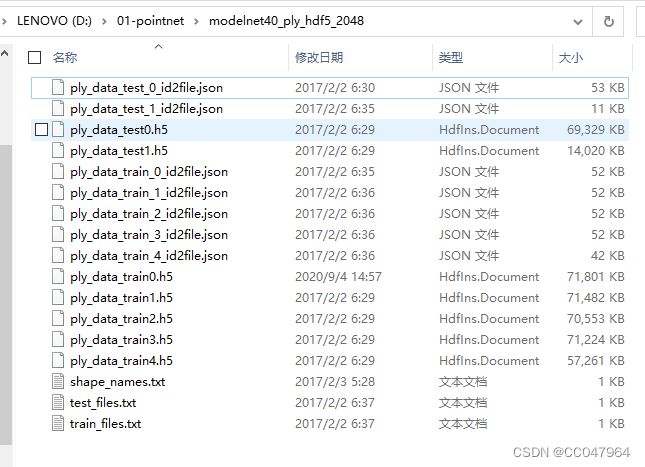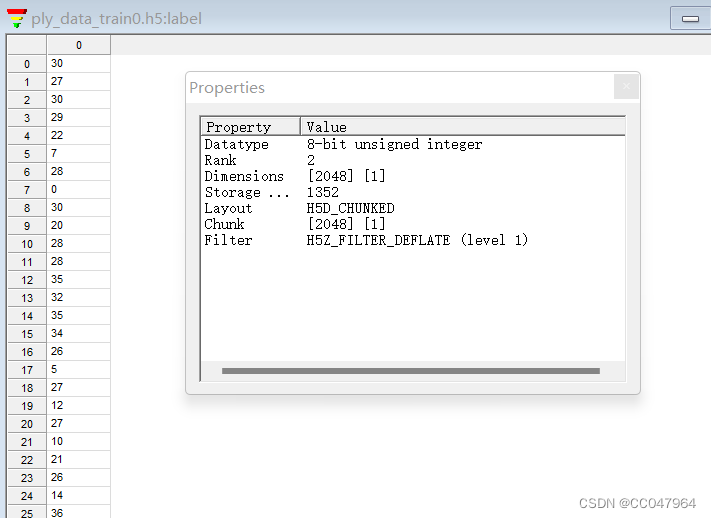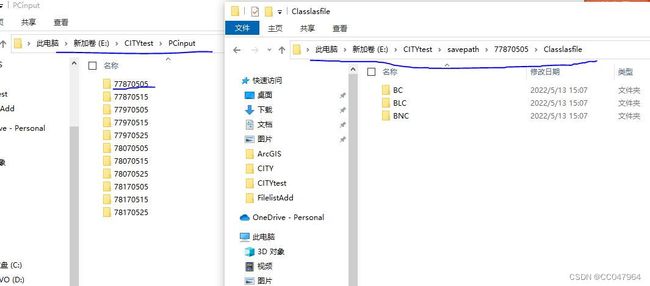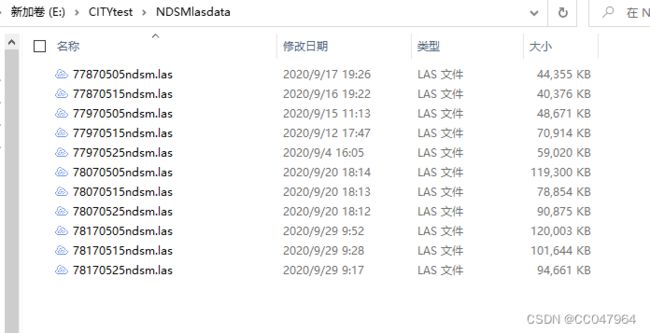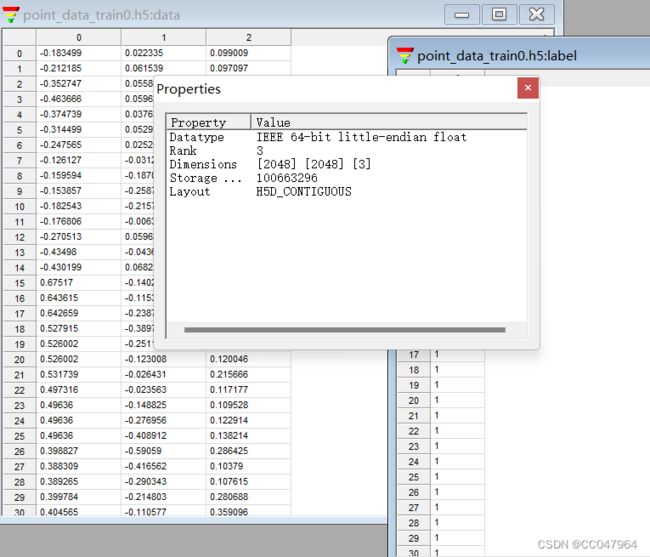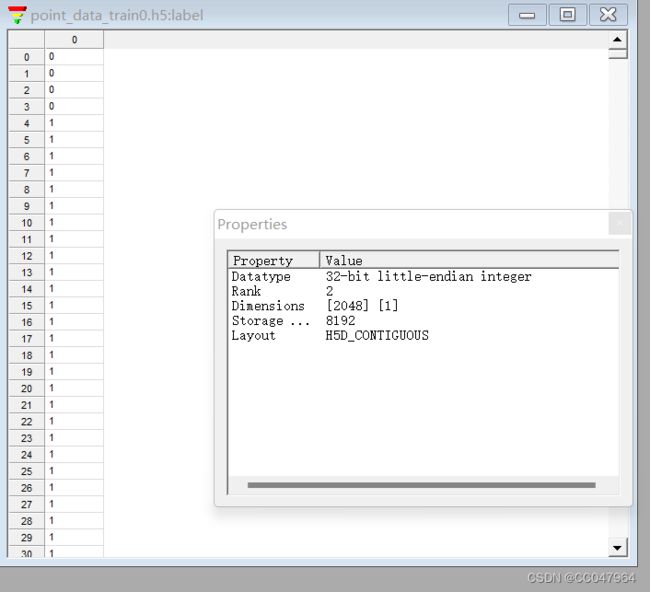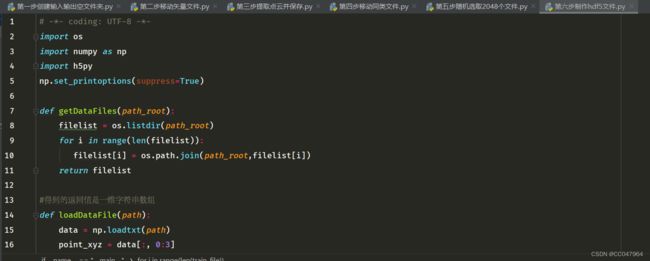制作PointNet以及PointNet++点云训练样本
目录
一、明确问题:
1.1、 标准数据集参考:
1.2 、HDF5数据组织形式:
二、开始制作数据集
2.1、数据标注,本人使用了Arcgis软件进行标注
2.2、样本点云提取,采样,归一化
1):根据点云las名称和类别名称文件,创建输入输出存储的三级文件夹
2):提取las数据,保存为txt
3):按shp正式开始提取----点云加底面----采样为2048---标准化归一化----存储为las和txt格式
4):最后,可以把同类别样本移动到一起,并计算样本总数量
编辑
3、保存制作为hdf5文件
3.1、首先 需要不重复的选择 2048 个样本,代码如下:
3.2、最后,保存制作hdf5文件
4、最终
一、明确问题:
1.1、 标准数据集参考:
制作自己的PointNet、以及PointNet++ 网络中 classification (分类)使用的标准点云样本数据集包含(XYZ)坐标以及(label)标签信息。
参考的github地址:https://github.com/charlesq34/pointnet
仿照的标准分类数据:modelnet40_ply_hdf5_2048,组织为.h5格式,test_files,train_files以及shape_names。
标准数据链接为:
1.2 、HDF5数据组织形式:
data: data中共有 2048个 2048 行*3列的 点云矩阵,即每个hdf5文件中有 2048个点云样本,每个点云样本中又有2048个点,每个点包括 (XYZ)三个坐标信息,所以矩阵表示是 2048*2048*3(2048个样本,每个样本2048个点,每个点包含XYZ三个坐标)。
label: 因为数据是2048个点云样本,每一个样本有属于一个类别,(虽然每个样本有2048个点,但这是一个样本,其中所有点也属于一类),所以每个样本一个类别,2048个样本有2048*1个类别。这是label的组织格式,可以减少一些数据量
即:
data: 2048*2048*3
label:2048*1
二、开始制作数据集
2.1、数据标注,本人使用了Arcgis软件进行标注
首先 加载 需要的 点云(已经经过预处理的),建立 shp文件开始勾画,
2.2、样本点云提取,采样,归一化
勾画完成,python调用gis工具批量按照不同类别分类提取,并同时建立label信息。
(本实验将研究区划分了BC,BLC,BNC三个类别,分别标注0,1,2)
1):根据点云las名称和类别名称文件,创建输入输出存储的三级文件夹
输入数据:两个txt,放入一个文件夹:(需要自己创建,一个是类别名称txt,自己命名类别,一个是自己点云块的名称,没有点云块可以根据自己实际状况调整).
根据shapelabel , 和 lasname 创建输入数据,输出数据存储的三级文件夹,如下代码:
因为本人还想保留过程数据,比如单个类别的shp,las文件,所以给了file_class变量,最终只需要txt文件。(根据个人情况调整),创建的文件夹,一级:lasname,二级: file_class = ['Classshpfile', 'Classlasfile', 'Classtxtfile'], 三级: shapelabel = ['BC','BLC','BNC']
# -*- coding: UTF-8 -*-
import os
import shutil
# 获取文件中内容
def GetData_fromFile(list_filename):
return [line.rstrip() for line in open(list_filename,'r')]
if __name__ == '__main__':
# 输入输出根目录
Input_path_root = 'E:\CITYtest\PCinput/'
Out_path_root = 'E:\CITYtest/savepath//'
# shapelable.txt和lasname.txt需根据自己的数据先创建,
shapename = GetData_fromFile('E:\CITYtest\FilelistAdd\shapelable.txt')
lasname = GetData_fromFile('E:\CITYtest\FilelistAdd\lasname.txt')
# 最后需要存储什么类型文件,根据自己需要
file_class = ['Classshpfile', 'Classlasfile', 'Classtxtfile']
# 建立三级存储文件夹,因为要同时存储每一大点云文件提取的每个类别样本的 las,shp,和txt文件
# 也就是,一级:点云数据名称 ; 二级:las,shp,txt,三级:BC,BLC,BNC
# 实际可根据自己的需要建立存储文件夹
for m in range(len(lasname)):
#创建 空的 输入文件夹
Input_path_make = os.path.join(Input_path_root,lasname[m])
if not os.path.exists(Input_path_make): # 判断文件夹是否已经存在
os.makedirs(Input_path_make)
else:
shutil.rmtree(Input_path_make)
os.makedirs(Input_path_make)
# 创建 空的 输出文件夹
for i in range(len(file_class)):
for j in range(len(shapename)):
# 文件路径
Out_path_make = os.path.join(Out_path_root,lasname[m],file_class[i],shapename[j])
if not os.path.exists(Out_path_make): # 判断文件夹是否已经存在
os.makedirs(Out_path_make)
else:
shutil.rmtree(Out_path_make)
os.makedirs(Out_path_make)
print('111')执行成功:
2):提取las数据,保存为txt
准备数据:shp矢量文件,las点云数据,以及第一步提到的lasname和shapelabel的txt文件。
2.1、 准备shp数据
把数据标注勾画好的shp文件放进(移动)创建的PCinput文件中(各个名称对应)。
# -*- coding: UTF-8 -*-
import os
import shutil
def GetData_fromFile(list_filename):
return [line.rstrip() for line in open(list_filename,'r')]
if __name__ == '__main__':
lasname = GetData_fromFile('E:\CITYtest\FilelistAdd\lasname.txt')
old_path_shp = 'E:\CITYshp\LASshpAdd/' # 源文件夹
for j in range(len(lasname)) :
new_path = 'E:\CITYtest\PCinput/' + lasname[j]#目标文件夹
filename = os.listdir(old_path_shp)
for file in filename:
#srcdir, tempfilename = os.path.split(fns[i]) ##分离绝对路径,文件名加后缀,得到的是路径和文件名加后缀
fn1, extend1= os.path.splitext(file) # 分离文件名和后缀
fn, extend = os.path.splitext(fn1) # 再次分离文件名和后缀,因为出现了.shp.xml的文件,对于.shp的不影响。
# 字符串截取 是闭区间。
if fn[3:] == lasname[j]:
shutil.copy(os.path.join(old_path_shp,file), os.path.join(new_path,file))
print('666')执行成功:
2.2 、准备las数据,我的las数据是已经预处理完的nDSM点云。
2.3 准备第一步提到的存储las名称和label名称的txt文件。
3):按shp正式开始提取----点云加底面----采样为2048---标准化归一化----存储为las和txt格式
代码如下
# -*- coding: utf-8 -*-
# 注意此时的laspy,有版本问题,2.0以上的版本就会出现问题,此时的版本是1.7.0
from laspy.file import File
import os
import arcpy
import shutil
import numpy as np
np.set_printoptions(suppress=True)
# 获取txt文件中的各种文件
def GetData_fromFile(list_filename):
return [line.rstrip() for line in open(list_filename,'r')]
# 只获取文件里面的shpfile中的shp文件
def Get_specific_File(dir, ext):
need_file = []
allfiles = os.listdir(dir)
for i in range(len(allfiles)):
name,extend = os.path.splitext(allfiles[i])
if extend[1:] == ext:
root_shp_path = os.path.join(dir,allfiles[i])
need_file.append(root_shp_path)
return need_file
#分割对应点云块的shp文件,以便于下一步提取
def split_move_shp(shp_path, out_path, label,splitfield):
arcpy.Split_analysis(in_features = shp_path, split_features = shp_path,
split_field = splitfield, out_workspace = out_path)
all_files = os.listdir(out_path)
for k in range(len(label)):
move_path_dir = os.path.join(out_path, label[k])
for file in all_files:
name_first, ext_first = os.path.splitext(file) # 分离文件名和后缀
f_name, ext_second = os.path.splitext(name_first) # 再次分离文件名和后缀,因为出现了.shp.xml的文件,对于.shp的不影响
if f_name[:-4] == label[k]:
shutil.move( os.path.join(out_path,file), move_path_dir)
# 点云规范化
def PC_NORMLIZE(pc):
centroid = np.mean(pc, axis=0)
pc = pc - centroid
m = np.max(np.sqrt(np.sum(pc**2, axis=1)))
pc = pc / m
return pc
# 采样到2048
def sample_data(data, num_sample):
""" data is in N x ...
we want to keep num_samplexC of them.
if N > num_sample, we will randomly keep num_sample of them.
if N < num_sample, we will randomly duplicate samples.
"""
N = data.shape[0]
if (N == num_sample):
return data
elif (N > num_sample):
sample = np.random.choice(N, num_sample)
return data[sample, ...]
else:
# 相当于从N中抽取 num_sample - N个随机数组成一维数组array,成为data的下标索引值
sample = np.random.choice(N, num_sample - N)
dup_data = data[sample, ...] # 取数据
# 按行拼接
return np.concatenate([data, dup_data], axis=0)
# return np.concatenate([data, dup_data], 0), list(range(N)) + list(sample)
if __name__ == "__main__":
las_name = GetData_fromFile('E:\CITYtest\FilelistAdd/lasname.txt')
label_name = GetData_fromFile('E:\CITYtest\FilelistAdd\shapelable.txt')
#自定义需要得到什么类型的文件数据
file_class = ['Classshpfile', 'Classlasfile','Classtxtfile']
#输入文件·路径
input_shp_dir = 'E:\CITYtest\PCinput//'
input_las_dir = 'E:\CITYtest/NDSMlasdata//'
save_dir = 'E:\CITYtest\savepath/'
for m in range(len(las_name)):
# 每个类别shp文件的路径
shp_save_path = save_dir + '/'+ las_name[m] + '/'+ file_class[0]
las_save_path = save_dir + '/'+ las_name[m] + '/'+ file_class[1]
txt_save_path = save_dir + '/'+ las_name[m] + '/'+ file_class[2]
# 获取每整个点云块的shp文件
# 注意shp_full 是一个列表文件,不是直接变量,引用时需要用shp_full[0,1,2]
shp_full = Get_specific_File(os.path.join(input_shp_dir, las_name[m]), 'shp')
# # # 开始对整个shp文件分割
if len(shp_full) != 0:
split_move_shp( shp_full[0], shp_save_path, label_name,'newname')
# 数据分割完毕,开始进行las点云提取
# 得到每个label文件下的shp文件
# 定义要提取的las路径,开始提取
all_las_list = os.listdir(input_las_dir)
las_ndsm_name,extend = os.path.splitext(all_las_list[m])
root_extract_las = os.path.join(input_las_dir, all_las_list[m])
for i in range(len(label_name)):
# 获取每个类别的单个样本shp
single_shp_path = os.path.join(shp_save_path, label_name[i])
shp_list = Get_specific_File(single_shp_path, 'shp')
# 提取单个las的路径
single_las_save = os.path.join(las_save_path, label_name[i])
if len(shp_list) != 0:
for j in range(len(shp_list)):
stir = str(j + 1)
st = stir.zfill(4) # 补零补够四位数
arcpy.ddd.ExtractLas(in_las_dataset = root_extract_las,
target_folder = single_las_save,
boundary= shp_list[j],
name_suffix=label_name[i] + st, remove_vlr=True,
rearrange_points='REARRANGE_POINTS', )
las_list_path = os.path.join(single_las_save, las_ndsm_name + label_name[i] + st + '.las')
# 只提取样本las中的X,Y,Z和intensity,raw_classification信息
f = File(las_list_path, mode='rw')
# 改变样本标签为 0,1,2
# print(f.x.shape)
point_cloud = np.vstack((f.x, f.y, f.z, f.intensity, f.raw_classification)).T
point_cloud[:,4] = i
# 给点云加上底面,获取行数
row_num = point_cloud.shape[0]
# 生成和行数一 样的一维0数组
z_back = np.zeros(row_num)
# 底面
point_back = np.vstack((f.x, f.y, z_back, f.intensity, f.raw_classification)).T
# 屋顶和底面放一起
# print(point_back.shape)
point_cloud_add = np.vstack((point_cloud, point_back))
# point_cloud_add = np.concatenate((point_cloud, point_back),axis=0)
# 采样到2048
sample_pc = sample_data(point_cloud_add, 2048)
# 只取数据坐标信息归一化,中心化
pc_norm = PC_NORMLIZE(sample_pc[:, 0:3])
# 规范后数据代替原来的坐标
sample_pc[:, 0:3] = pc_norm
# 存储为txt格式
single_txt_save = os.path.join(txt_save_path,label_name[i])
np.savetxt( os.path.join(single_txt_save , las_name[m] + label_name[i] + st + '.txt'),
sample_pc, fmt="%.6f", delimiter=" ")
else:
print ("该类别无样本数据")
else:
print('该块las的样本shp为空')
print('successful')
print('over')
运行成功,结果如下:(没放完)
至此,得到各个点云块,各个类别的单个样本数据。
4):最后,可以把同类别样本移动到一起,并计算样本总数量
# -*- coding: UTF-8 -*-
import os
import shutil
import numpy as np
import pandas as pd
def GetData_fromFile(list_filename):
return [line.rstrip() for line in open(list_filename, 'r')]
if __name__ == '__main__':
las_name = GetData_fromFile('E:\CITYtest\FilelistAdd/lasname.txt')
label_name = GetData_fromFile('E:\CITYtest\FilelistAdd\shapelable.txt')
# 自定义需要得到什么类型的文件数据
file_class = ['Classshpfile', 'Classlasfile', 'Classtxtfile']
# # 输入文件·路径
save_dir = 'E:\CITYtest\savepath/'
class_dir = 'E:\CITYtest\Allclass/'
count = 0
sum_count = 0
num_sample = np.zeros((len(label_name)+1, 1), dtype=int)
# # 创建同类别文件夹
for i in range(len(label_name)):
move_dir = os.path.join(class_dir, label_name[i])
if not os.path.exists(move_dir): # 判断文件夹是否已经存在
os.makedirs(move_dir)
else:
shutil.rmtree(move_dir)
os.makedirs(move_dir)
# 如下:分别计算每个类别样本数量
for i in range(len(label_name)):
for m in range(len(las_name)):
# 每个类别shp文件的路径
root_txt_path = save_dir + '/' + las_name[m] + '/' + file_class[2] + '//'+ label_name[i]
all_txt_list = os.listdir(root_txt_path)
# 计数一共有多少个样本
count = count + len(all_txt_list)
# 开始移动
for j in range(len(all_txt_list)):
old_file_path = os.path.join(root_txt_path, all_txt_list[j])
new_file_path = os.path.join(class_dir + '/' + label_name[i], all_txt_list[j])
shutil.copy(old_file_path, new_file_path)
num_sample[i,0] = count
sum_count = sum_count + count
count = 0
num_sample[len(label_name),0] =sum_count
label_name.append('sum')
df_num = pd.DataFrame(num_sample, index=label_name, columns=["number"])
print(df_num)
print('over')
运行结果如下:得到总样本数量5526个,以及各个类别的样本数量。
3、保存制作为hdf5文件
明确第一步的问题,每个hdf5的data 和label包含的数据:看第一步的介绍
data: 2048*2048*3
label:2048*1
那么,由于目前样本只有5526个, 可以大概分为 2个 hdf5 文件,即:所以,创建一个train,和一个test,如果有更多的样本可以依次组织 train_2,3,4,5......等等。
3.1、首先 需要不重复的选择 2048 个样本,代码如下:
# -*- coding: UTF-8 -*-
import os
import random
import shutil
def select_file_rand(source_path, out_path, num):
num_list = 0
list_file = os.listdir(source_path)
if num > len(list_file):
print('输出数量必须小于:', len(list_file))
exit()
else:
num_list = random.sample(range(0, len(list_file)), num) # 生成随机数列表a
for n in num_list:
filename = list_file[n]
old_path = os.path.join(source_path, filename)
new_path = os.path.join(out_path, filename)
shutil.move(old_path, new_path)
print('==========task OK!==========')
if __name__ == "__main__":
# train_file = ['train0', 'train1', 'train2', 'train3', 'train4', 'train5', 'test0']
train_file = ['train0', 'test0']
source_file = r'E:\CITYtest\Allclass/allfile'
out_dir = 'E:\CITYtest\Trainfile'
net_num = 2048
for i in range(len(train_file)):
out_file = os.path.join(out_dir, train_file[i])
os.makedirs(out_file)
select_file_rand(source_file, out_file,net_num) # 操作目录,输出目录,输出数量
3.2、最后,保存制作hdf5文件
data: 2048*2048*3
label:2048*1
# -*- coding: UTF-8 -*-
import os
import numpy as np
import h5py
np.set_printoptions(suppress=True)
def getDataFiles(path_root):
filelist = os.listdir(path_root)
for i in range(len(filelist)):
filelist[i] = os.path.join(path_root,filelist[i])
return filelist
#得到的返回值是一维字符串数组
def loadDataFile(path):
data = np.loadtxt(path)
point_xyz = data[:, 0:3]
label=data[:,4]
label_int = label.astype(int)
return point_xyz, label_int
if __name__ == "__main__":
train_file = ['train0', 'test0']
net_num = 2048
train_dir = 'E:\CITYtest\Trainfile//'
for i in range(len(train_file)):
root_file = os.path.join(train_dir,train_file[i])
DATA_FILES = getDataFiles(root_file)
DATA_ALL = []
LABEL_ALL = []
for fn in range(len(DATA_FILES)):
pre_data, his_label = loadDataFile(DATA_FILES[fn])
pre_label = his_label.reshape(net_num, 1) # 重塑为num行1列的数据 得到num个点云的标签
# data_label = np.hstack((pre_data, pre_label))
DATA_ALL.append(pre_data) #列表元素
# label一个样本中的类别是一样的,取一个数字就可以了
LABEL_ALL.append(pre_label[0])
# 把DATA_ALL和LABEL_ALL的列表转换成数组格式,
out_data = np.vstack(DATA_ALL)
out_label = np.vstack(LABEL_ALL)
# 重塑为三维数组,2048 个 2048*4 的三个数组
data_reshape = out_data.reshape(net_num, net_num, 3)
# 写入训练数据
filename= train_dir +'/'+ 'point_data_' + train_file[i] + '.h5'
if not os.path.exists(filename):
with h5py.File(filename, 'w') as f:
f['data'] = data_reshape
f['label'] = out_label
f.close()
else:
print('hdf5文件已存在')
print("over")
最终结果如下:,即可在linux中进行训练,
4、最终
其中有些步骤可以简化,可以改变,可以修改,可以整合,仅供参考,fangbia非常感谢大家。
如下是自己程序运行的步骤,也是上述代码的顺序,仅供参考,
